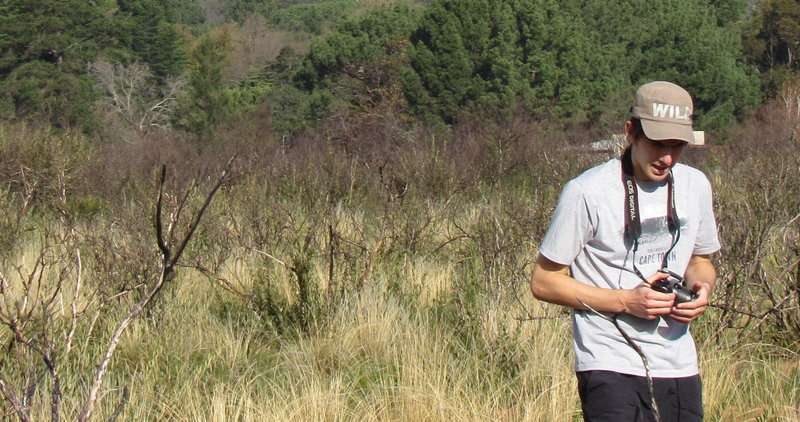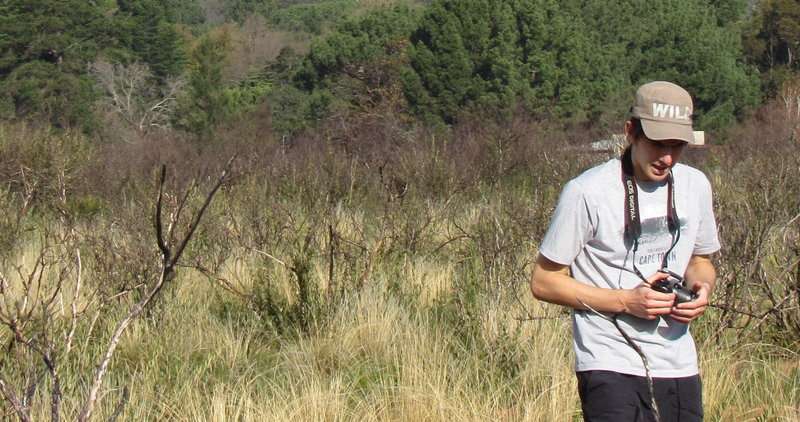
- The restoration of fynbos is possible in areas where pines used to grow for up to 30 years, because there are still enough native fynbos seeds left in the soil.
- To save costs, time and effort when rehabilitating sites, pine plantations and areas invaded by pines should be cleared within 40 to 50 years.
Here is some advice for landowners who want to remove pine trees from their properties in the hope of seeing fynbos plants grow there again: if you have any choice in the matter, do so before the trees have grown there for more than 30 years. The longer you wait, the less likely the chances that any fynbos seeds will be left in the soil to sprout successfully. This is according to research in the South African Journal of Botany that was conducted by researchers from Stellenbosch University and the City of Cape Town in South Africa.
Soil and plant samples were analysed by Stellenbosch University postgraduate student Alistair Galloway of the Department of Conservation Ecology and Entomology.
Galloway says he decided on the topic because not as much research has gone into the restoration of fynbos veld after the removal of pines as have been done about the clearing of acacia trees. His efforts not only led to him now publishing his first peer-reviewed paper, but also receiving his department’s Daniel Booysen Memorial Award for the best 4th year project conducted in 2016. Galloway recently also received a Rector’s Award for Academic Excellence from Stellenbosch University.
His co-authors and supervisors are three respected researchers of matters relating to the impact of invasive species on the Cape Floral Kingdom’s indigenous fynbos plants. They are Dr Pat Holmes of the City of Cape Town’s Environmental Management Department (and an Extraordinary Associate Professor of the Department of Conservation Ecology and Entomology), Dr Mirijam Gaertner of the Nürtingen-Geislingen University of Applied Sciences in Germany, and Prof Karen Esler of Stellenbosch University’s Department of Conservation Ecology and Entomology. Galloway’s project was funded through the Centre of Excellence for Invasion Biology based at Stellenbosch University, to which Gaertner, Holmes and Esler are also affiliated.
The study was conducted in the Helderberg Nature Reserve, which is managed by the City of Cape Town. It’s a reserve that Galloway, who hails from Somerset West, has frequented since childhood. For his research project, Galloway compared sites where naturally occurring vulnerable Cape Winelands Shale fynbos grow with those on which Pinus radiata pines were planted in the 1960s. The study sites were all burnt in the autumn of 2015.
Trees in three of the plantation sections were felled between 1992 and 1994. Over the past 20 years, the natural plants that used to grow there have had an opportunity to regrow. Trees from another three sections were only felled in the winter of 2014, and were therefore under pine plantations for about 50 years.
The sooner, the better for fynbos
Galloway took soil samples to find out if there were still any viable fynbos seeds left in the soils of the former plantation sites. He also noted how the natural vegetation grew back after the trees were removed and the areas burnt. A high number of seeds from different types of native fynbos species were still to be found in the soils of areas from which 30-year-old pines were removed. The fynbos plants also regrew at a similar density to that of the undisturbed fynbos areas. However, the same could not be said of the areas on which 50-year-old trees had stood, as there was little left of the native seed bank stored in the soil.
According to Galloway, seeds that survive in the soil makes it possible for some of the plants that used to be found there to regrow on the 30-year-old plantation sites. Active restoration steps to re-introduce species from surrounding areas might be needed on the 50-year-old sites, to ensure the recovery of native plants that once grew there, and to prevent possible soil erosion on the cleared area. “Because there’s very little native seed left in the ground, restoration work on older sites will be much more time consuming and costly,” he says.
According to Prof Esler, pine plantation and invasion management in the Fynbos biome should consider for how long pines have grown in an area. The shorter, the better for the rehabilitation of fynbos veld.
“This helps to maintain the native seed bank and the recovery potential of fynbos, and minimises the need for active restoration,” adds Prof Esler. “Long-term follow-up control of several alien species will also need to be implemented so that the alien seed bank can be depleted, and the survival of restored native species can be maximised.”
###
Reference: A.D. Galloway, P.M. Holmes, M. Gaertner, K.J. Esler (2017). The impact of pine plantations on fynbos above-ground vegetation and soil seed bank composition, South African Journal of Botany
Photo caption: Stellenbosch University student Alistair Galloway on one of his field trips during the course of his research work.
Media Contact
Martin Viljoen
[email protected]
27-218-084-921
@scienceSUN
http://www.sun.ac.za
http://www.sun.ac.za/english/Lists/news/DispForm.aspx?ID=5277





